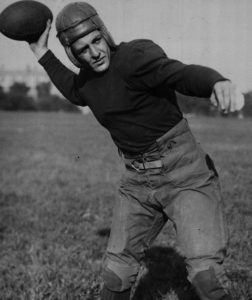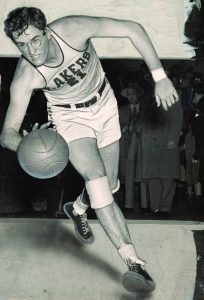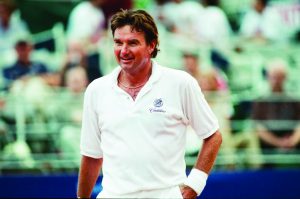Bicentennial 2018: Top 10 athletes from Illinois
By Mark Potash Of the Chicago Sun-Times — January 4, 2018
Illinois has produced many outstanding and game-changing athletes, so it’s a tough job to create any top 10 list.
The Illinois Press Association and Illinois Associated Press Media Editors enlisted longtime Chicago Sun-Times sports reporter Mark Potash for the job. Here is his list of the top 10 athletes from Illinois.
- Red Grange, Wheaton
The early days of professional football were not pretty or promising — obviously not televised but also casually recognized. The Bears and Cardinals were relegated to secondary pages of the sports sections in Chicago, with college football dominant and even high school football more prominent.
And more than that, pro football was a second-class citizen in American sport — considered substandard to college football and to some, an unseemly, disrespected profession. The best college players didn’t automatically go to the National Football League.
Red Grange helped change all of that. The running back from Wheaton and the University of Illinois rivaled even Babe Ruth and Jack Dempsey as an American sports star in the 1920s. When he signed with the Bears out of Illinois in 1925, he almost single-handedly changed the face of the NFL — giving it an instant credibility that was reflected in banner headlines and sell-out crowds.
Grange’s debut with the Bears on Thanksgiving Day drew 36,000 fans at Cubs Park — the largest crowd in the then-brief history of the future Wrigley Field. Ten Days later, Grange drew a record 65,000 to the Polo Grounds for a game against Tim Mara’s fledgling New York Giants — an event that without exaggeration is credited with not only saving that franchise, but leaving an impression on Eastern sports writers that further legitimized pro football. On a winter barnstorming tour following the season, Grange and the Bears drew a record 65,270 to the Los Angeles Coliseum.
As it turned out, Red Grange’s impact on the field would never match all of that. While playing for the New York Yankees in 1927 after a salary dispute with the Bears, Grange suffered a knee injury and missed the 1928 season. He returned to the Bears in 1929, but had lost the speed and agility that made him a superstar. He made his mark as an outstanding defensive back — most notably making a touchdown-saving tackle on the final play that clinched the Bears’ 23-21 victory over Giants in the NFL championship game. He was inducted into the Pro Football Hall of Fame in 1963.
All things considered, no player from Illinois has had more impact on a sport than Red Grange. He was a four-sport star at Wheaton High School who scored 75 touchdowns. He became a superstar as a three-time All-American at Illinois who famously rose to the occasion of the big game when he scored four touchdowns in the first quarter against Michigan in 1924 at newly dedicated Memorial Stadium — a 95-yard return of the opening kickoff, plus runs of 67, 56 and 44 yards. In those days he was a larger-than-life star, his No. 77 was almost as famous as he was. And even then, the best was yet to come.
- Dick Butkus, Chicago

Los Angeles coach Sid Gillman talks over title strategy with his two pass catching ends Elroy Hirsch (center) and Bob Boyd as team prepares for Monday’s National Football League championship game against Cleveland at Los Angeles.
The greatest tribute to Dick Butkus’s fabulous NFL career is that as time passes and the linebacker position evolves arguably more than any in football — bigger, faster, greater athletes with triple-digit career sack numbers — his stature continues to grow. The former Vocational High School and University of Illinois star still is No. 3 in most linebacker rankings. Some still say he’s the greatest linebacker to play the game. The Butkus Award is given to the best linebacker not only in college, but in high school and the NFL.
Why? Because even with all-time greats such as Lawrence Taylor and Ray Lewis joining the best-of-all-time discussion, there always will only be one Dick Butkus. As the late Doug Buffone often said, “To play this game you have to have the Neanderthal gene — Butkus had two.”
But Butkus’ greatness lies deeper than that. It’s almost a shame that Butkus’ reputation as a mean, angry, dirty player overshadows the reality that he was one of the most instinctive, disciplined, fundamentally sound and opportunistic players ever. He had a knack for being in the exact spot to make that brutal hit. And he had great hands. It’s almost ironic that Butkus, despite his reputation, was one of the cleanest, surest tacklers of all-time.
He was named to the All-Pro team five times and the Pro Bowl eight times. In 119 NFL games, he had 22 interceptions and 27 fumble recoveries. And the ferocity with which he played was real. Buffone, who played next to Butkus for seven years, often recalled looking at a frothing Butkus on the field and thinking, “I’m glad he’s on my side.”
- George Mikan, Joliet
At 6-10, George Mikan was the first superstar of professional basketball — the first big-man who could run the floor and dominate at the rim on both ends. His impact forced three rules changes: goaltending, widening of the lane and the 24-second clock. When he played with the Minneapolis Lakers in 1949, the marquee at Madison Square Garden said it all: “GEO MIKAN V/S KNICKS.”
An awkward, un-athletic prospect from Quigley Prep/Joliet Catholic, Mikan flourished under Ray Meyer’s tutelage at DePaul, becoming a three-time All-American and two-time Player of the Year in college. He won seven professional league championships, including one with the Chicago American Gears of the fledgling National Basketball League and six with the Lakers.
- Isiah Thomas, Chicago
The epitome of the head-strong, will-to-win Chicago point guard, Isiah Thomas parlayed his innate skills and determination into superstardom and championships.

Chicago’s Michael Jordan (left) knocks the ball away from Detroit’s Isiah Thomas during the second quarter of Monday’s NBA playoff game at Chicago Stadium.
A west side native, he took St. Joseph High School in Westchester from anonymity to second place in the Class AA state tournament in 1979. He led Indiana to the NCAA title in 1981 and was the spark plug on the Pistons’ back-to-back NBA titles in 1989 and 1990.
Thomas was a 12-time NBA all-star and was inducted into the Naismith Hall of Fame in 2000
- Jackie Joyner-Kersee, East St. Louis
A basketball and track star at East St. Louis Lincoln and UCLA, Jackie Joyner-Kersee made her biggest mark in international track competitions, particularly the Olympics, where she won six medals in four different Olympics — including a silver medal in the heptathlon in 1984 in Los Angeles and gold in the heptathlon in 1988 in Seoul and 1992 in Barcelona.
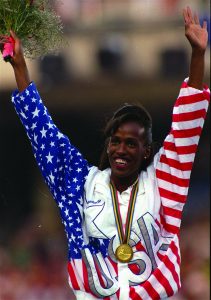
USA’s Jackie Joyner-Kersee of Canoga Park, Calif., waves during medal ceremonies for the women’s heptathlon at the Olympic Games in Barcelona Monday, August 3, 1992. Joyner-Kersee received the gold in the event. (AP Photo/Deither Endlicher)
She was named the greatest female athlete of all time by Sports Illustrated for Women in 1990.
- Otto Graham, Waukegan
The Big Ten Player of the Year at Northwestern — where he also played basketball and baseball — in 1943, Otto Graham became a prolific quarterback and one of the great leaders of pro football history.
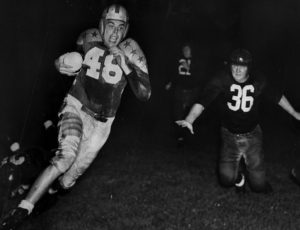
Speedy Otto Graham(48), all Star halfback from northwestern, puts on full speed as he races for a 20-yard gain in the second quarter of the all star Washington redskins football game AUG, 25 at Dyche stadium, Evanston, ill, ‘wee Willie” Wilkin(36), Washington tackle, falls to the ground as he attempts to get to Graham,
He won seven league titles with Paul Brown’s Cleveland Browns in the old All-American Football Conference (1946-49) and NFL (1950, 1954 and 1955) and three NFL Most Valuable Player awards (1951, 1953, 1955).
- Ray Nitschke, Maywood
A rough-and-tough, fierce competitor from Proviso High School, Ray Nitschke was a third-round draft pick by the Packers out of Illinois who was at the right place at the right time — becoming an intimidating force as the leader of the great Packer defenses in the Vince Lombardi era.

Ray Nitschke (right) MLB for the Green Bay Packer football team receives a tape job from Bud Jorgensen trainer for the team.
Nitschke won five NFL championships with the Packers, including the first two Super Bowls. He was the MVP of the 1962 championship game.
- Jimmy Connors, Belleville
The “Brash Basher of Belleville,” as tennis guru Bud Collins called him, the East St. Louis native was a gritty, guttsy, unconventional player and non-conformist who is credited with sparking a re-birth in American tennis in the early 1970s. Jimmy Connors won eight Grand Slam titles, a record 109 singles titles and was ranked No. 1 in the world for 268 weeks, including a then-record 160 straight from 1974-77.
In 1974 at age 22, Connors went 99-4 and won 15 tournaments, including three Grand Slam events — the Australian Open, U.S. Open and Wimbledon.
He was barred from the French Open (the second leg) because of a contract with the World Team Tennis, costing him a chance to win the Grand Slam.
- Lou Boudreau, Harvey
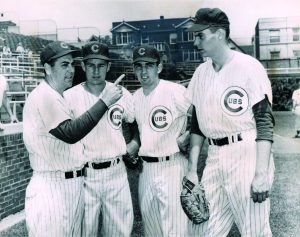
7-17-2003 Copy of Sun-Times file photo from a June, 1960 photo at Wrigley Field of the Cubs’ Kiddie Corps. left to right: Manager Lou Boudreau, third baseman Ron Santo, 20yr.; outfielder Danny Murphy, 17yr.; and pitcher Dick Ellsworth. Chicago Sun-Times Library Archive file photo.
A Hall of Fame shortstop with the Cleveland Indians, Lou Boudreau had one of the greatest baseball seasons of all-time as player/manager in 1948. He won the American League batting title (.355) and MVP award and led the Indians to the World Series championship — the only title the Indians have won since 1920.
Great knack for leadership, Boudreau won a state title in basketball as a sophomore at Thornton and Big Ten titles as team captain in basketball and baseball at Illinois.
- Bonnie Blair, Champaign
Bonnie Blair won five gold medals at three different Olympic Games, capped by a dominating performance in 1994 at Lillehammer, when she won the 500-meters (by 0.36 seconds) and 1,000 meters (by a record-1.38 seconds) by wide margins.
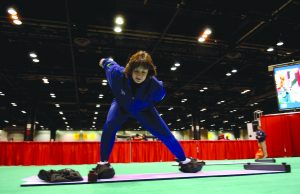
12-28-06 McCormick Place, Chicago –
Olympic speed skater Bonnie Blair demonstrates skating techniques on a slide board during Mayor Daley’s Holiday Sports Fest at McCormick Place Thursday in Chicago.
-John J. Kim/Sun-Times
She was the first American to win an event (the 500-meters) in three consecutive Olympics. She won the Sullivan Award as the best amateur athlete in the U.S. in 1992.
Chicago Sun-Times sports writer Mark Potash can be reached at mpotash@suntimes.com and on Twitter at @MarkPotash.
Editor’s note:
The weekly Illinois Bicentennial series is brought to you by the Illinois Associated Press Media Editors and Illinois Press Association.
More than 20 newspapers are creating stories about the state’s history, places and key moments in advance of the Bicentennial on Dec. 3, 2018. Stories published up to this date can be found at 200illinois.com.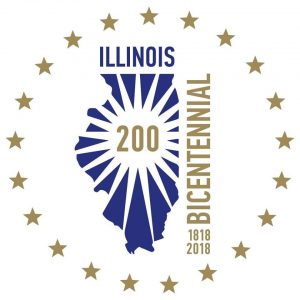
Bicentennial 2018: The story of Illinois’ first state city, the quiet capital

